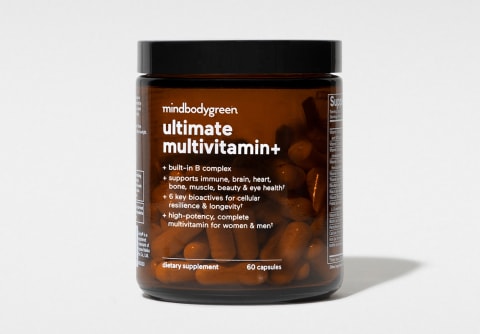Advertisement
4 Benefits Of Vitamin A, Including Healthy Skin, Immunity & More*


Ashley Jordan Ferira, Ph.D., RDN is Vice President of Scientific Affairs at mindbodygreen. She received her bachelor's degree in Biological Basis of Behavior from the University of Pennsylvania and Ph.D. in Foods and Nutrition from the University of Georgia.
If you know anything about vitamin A, it's probably that you can get your fix by eating carrots and that the nutrient is good for your eyes.* Thing is, there's actually a lot more to this vitamin than meets the, well, eye.
In addition to keeping your peepers in tiptop shape, vitamin A also helps your immune system function at its best and keeps cells growing and developing as they should (and that's not all, either).*
So, what else do you need to know? Consider this your crash course in all things vitamin A—from the different roles it plays throughout the body and the resulting benefits to what's at stake with deficiency, to how you can make sure you're not falling short.
What is vitamin A?
"'Vitamin A' is a generic term that refers to fat-soluble compounds found as preformed vitamin A (aka retinol) and as provitamin A carotenoids in fruit and vegetables," says Victoria J. Drake, Ph.D.,1 manager of the Micronutrient Information Center at Oregon State University. (Heard of beta-carotene? That's arguably the most important provitamin A carotenoid2 you'll find in fruits and veggies.)
When we consume these various compounds, our body converts them into whatever form of vitamin A it needs and can use, adds Adrian F. Gombart, Ph.D., a professor of biochemistry at Oregon State University's Linus Pauling Institute. When you eat carrots, which contain beta-carotene, for example, your body converts that beta-carotene to retinol. Depending on where in the body vitamin A is needed, your body can also convert retinol further into retinol or retinoic acid, which bind to receptors to regulate gene expression, he explains.
Clearly, there's a lot that goes on behind the scenes in order for your body to put the various forms of vitamin A you consume to work. When you consume retinol-containing animal foods, for example, the animal basically did one step of the process for you by converting the carotenoids they consumed from plants into that retinol form, notes Drake.
And when you consume carotenoids from plants, you gain the unique antioxidant attributes of beta-carotene, which is a phytonutrient (aka, plant nutrient).*
Summary
The benefits of vitamin A
The compounds we know as vitamin A contribute to a range of functions throughout the body. From the regulation of gene expression to the proper eye function to red blood cell production, the nutrient does an A+ job at keeping our bodies in working order.* It's also critical for embryonic and fetal organ development, Gombart adds.* Here's the lowdown on a few of its most important perks:
Immune function
An adequate intake of vitamin A contributes to the normal functioning of the immune system by supporting the integrity of the mucosal epithelium3 (a protective membrane that lines various organs).*
Research shows that when there's inadequate vitamin A, the integrity of this lining is suboptimal, affecting barrier function of the respiratory tract, digestive tract, and eyes against possible invaders or compounds we don't want to cross these barriers.* This is relevant since 45% of adults fall short4 on the nutrient.
Eye health
You surely learned early in life that beta-carotene-rich carrots are good for your eyes. Indeed, vitamin A is necessary for proper eyesight and needed in the rod cells found in the retina, which allow us to see in low light and even detect motion,* says Alexander Michels, Ph.D., a research associate at Oregon State University's Linus Pauling Institute. Without proper intake of it, one's eyesight can be significantly affected.
Maintaining ample vitamin A intake has, unsurprisingly, been linked with vision support via long-term eye health5.*
Healthy skin
Vitamin A is an essential nutrient for skin as it acts as an antioxidant and supports the process through which the skin regenerates.*
Its most famous skin-healthy version is actually topical: retinol, a vitamin A derivative. When applied to the epidermis, it promotes skin cell turnover, evenness, smoothness, and vitality6.
Reproduction & growth
Scientific literature has long acknowledged the importance of vitamin A for reproduction7—and researchers now know that the retinoic acid form of vitamin A, in particular, plays a role in both male and female reproductive health, as well as in the normal development of embryos.*
What's at stake with vitamin A insufficiency?
Because vitamin A is key to many essential functions in the body, inadequate intake of this nutrient can have a variety of impacts. One of the most notable, according to Michels, is undesirable changes in vision, particularly at night. Suboptimal thyroid function and changes in skin8 may also occur.
Furthermore, vitamin A deficiency also affects the immune system. Michels notes that vitamin A deficiency, particularly in children, has been linked to higher susceptibility to outside invaders, like viruses. In fact, partially for this reason, the World Health Organization9 has identified vitamin A deficiency as a notable public health problem in many parts of the world.
Sources of vitamin A
You can get vitamin A through dietary sources and through supplementation.
Vitamin A-rich foods
Plant sources of vitamin A10 are easy to spot because the carotenoids (like beta-carotene) in them give them distinct yellow and orange hues. Keep an eye out for these colors of the rainbow the next time you're in the produce section, and you'll see clear as day which fruits and vegetables will help you up your intake. Some of your many options include sweet potatoes, carrots, cantaloupe, and mango.
Green leafy vegetables—think broccoli, kale, spinach, and collards—also contain these carotenoids. However, the large amounts of chlorophyll, which gives these plants their green color, keeps those carotenoids from visibly shining through.
The ultimate (i.e., most concentrated) source of vitamin A, though, comes from an animal source—and one you may not be super-stoked to eat: beef liver11.
Supplements
Of course, you can also get your fair share of vitamin A from supplements; most quality multivitamin formulas include it in the mix. Though different supplements may contain different forms of the vitamin, many contain both retinol and beta-carotene8, for synergy reasons and to provide your body with both sources.
Dosage & toxicity
Also, vitamin A is fat-soluble and thus can store in fat tissue when consumed in very large amounts over time. Toxicity can be a concern with the retinol form (but not beta-carotene).
Wait, what's this about retinol (or preformed vitamin A) toxicity? Yes, there is such thing as too much vitamin A12, when you're getting it from animal sources and retinol-containing supplements. It does take consistent overconsumption of vitamin A from preformed sources to lead to excess build up in the body12. But if that does happen, these are the affects it can have:
- Nausea and vomiting
- Headaches
- Vision concerns
- Joint and bone discomfort
- Loss of appetite
Since the body can regulate how much retinol it produces from carotenoids you consume, you don't have to worry about overdoing it on plant foods that contain the vitamin.
Given that, it is important to be aware of how much preformed vitamin A (aka, retinol) you are ingesting. Specifically, 900 micrograms RAE (retinol activity equivalents) per day for adults is a healthy level to support sufficiency of this essential nutrient.
Excess retinol is considered a high dose of 3,000 mcg or above (i.e., the Tolerable Upper Intake Level11). Above this level, especially if you are pregnant13, there can be concerns related to normal development of the fetus.
What about vitamin A supplements?
Many supplements that contain vitamin A include a source derived from beta-carotene (alone or in combination with a retinol form). Since there are concerns about getting too much vitamin A, this is not a nutrient you want to over supplement with. Stay clear of high-dose retinol-based vitamin A. If you're looking at vitamin A as part of a multivitamin, it's a good sign if it provides around 100% of the daily recommended amount of the nutrient from a combination of beta-carotene and retinol.
The takeaway
Fat-soluble vitamin A is an essential nutrient for the proper functioning of various systems throughout the body. To keep our immune systems strong, our eyes seeing clearly, and more, it's crucial that we consume enough of this nutrient.*
13 Sources
- https://lpi.oregonstate.edu/mic/staff
- https://www.ncbi.nlm.nih.gov/pmc/articles/PMC5971251/
- https://www.cambridge.org/core/journals/british-journal-of-nutrition/article/selected-vitamins-and-trace-elements-support-immune-function-by-strengthening-epithelial-barriers-and-cellular-and-humoral-immune-responses/94B772EB747D1E5CD9FAC8F90937AA9F
- https://www.ncbi.nlm.nih.gov/pubmed/21865568
- https://www.ncbi.nlm.nih.gov/pmc/articles/PMC6523787/
- https://www.ncbi.nlm.nih.gov/pmc/articles/PMC7827176/
- https://www.ncbi.nlm.nih.gov/pmc/articles/PMC3257687/
- https://lpi.oregonstate.edu/mic/vitamins/vitamin-A
- https://www.who.int/elena/titles/vitamina_pregnancy/en/
- https://lpi.oregonstate.edu/mic/vitamins/vitamin-A#introduction
- https://ods.od.nih.gov/factsheets/VitaminA-HealthProfessional/
- https://www.ncbi.nlm.nih.gov/books/NBK532916/
- https://www.ncbi.nlm.nih.gov/pmc/articles/PMC6470929/
Watch Next
Enjoy some of our favorite clips from classes
Enjoy some of our favorite clips from classes
What Is Meditation?
Mindfulness/Spirituality | Light Watkins
Box Breathing
Mindfulness/Spirituality | Gwen Dittmar
What Breathwork Can Address
Mindfulness/Spirituality | Gwen Dittmar
The 8 Limbs of Yoga - What is Asana?
Yoga | Caley Alyssa
Two Standing Postures to Open Up Tight Hips
Yoga | Caley Alyssa
How Plants Can Optimize Athletic Performance
Nutrition | Rich Roll
What to Eat Before a Workout
Nutrition | Rich Roll
How Ayurveda Helps Us Navigate Modern Life
Nutrition | Sahara Rose
Messages About Love & Relationships
Love & Relationships | Esther Perel
Love Languages
Love & Relationships | Esther Perel


















